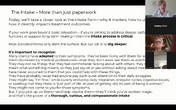Theory - Pathogenic Factors
Wind, Cold, Heat, Damp, Dry, and Fire
These are known as the 6 Evils, or 6 Excesses and each effects the system a bit differently.
Although its not necessary to learn about them in great detail for a bodywork practice, understanding their presence and how they effect the body can be very useful. Each has its own relationship with the 5 Elements and so I will address each of these in a little more depth when we study the elements that they effect the most.
Wind: Effects the Lung and Liver
Associated with the beginning of an illness with sudden onset and movement
Associated with internal (deep) illness with tremors, tics and spasm
Associated with certain emotional spiritual conditions such as Schizophrenia
Wind is commonly found to effect the physical body, due to its relationship to the Wood element, and its effect on the Blood. Both acute and chronic wind pathologies can be observed
acute wind: stiffness and or tremors/tics, muscle spasm, twitch or tic
chronic wind: autoimmune diseases, Parkinsons Disease, Multiple Sclerosis, Epilepsy
another common example, starts as acute and can become chronic : Bell's Palsy
Cold: Effects the Kidneys and Spleen
Causes contraction, stagnation, and pain.
Symptoms include chills, aversion to cold, cold limbs, painful digestion, body aches, frequent urination
Yang deficiency can be characterized by a feeling of cold, fatigue, and poor circulation especially in the extremities.
Often occurs after chronic heat pathogenic factor progresses over time and transforms into cold
External Cold can be characterized by: chills, runny nose, clear mucous and body aches.
Seasonal Influence is exacerbated with Yang deficiency, as the body’s yang retreats (south) internally to preserve body heat
Cold conditions have a somewhat natural occurrence due to ageing, as our Qi and Yang slows down and becomes depleted, less movement and mobility accelerate this process
Associated with conditions related with ageing such as Osteoarthritis and certain kinds of Rheumatiod arthritis
Excellent treatment: Moxibustion on ST 36
Heat: Effects the Heart, Stomach, Lungs
Excessive Yang energy, leading to inflammation, fever, and thirst.
Deficient Yin energy insufficient cold leading to heat rising (menopause)
Causes: food and drinks such as excessive coffee, meat, spicy foods, alcohol
Physical injury leading to inflammation
Stress
Emotional Imbalances
Natural Change of life in women, hormones and lower estrogen levels
Fire: The Extreme of Heat – going longer and deeper
When Heat becomes Fire, there is a more severe issue in the body, and it should be addressed
Signs: Fever, Agitation, insomnia, sweating, flushing, , internal dryness, coughing wheezing, shortness of breath, mouth sores, heart palpitations, night sweats, dizziness, tinnitis, forgetfulness
Causes: Emotions, hot and humid weather, spicy or contaminated food, unchecked pre-existing condition, chemotherapy
Damp: Effects the Spleen and Bladder
Characterized by heaviness, stagnation, and a feeling of sluggishness. Symptoms may include edema, a feeling of fullness, and a sticky tongue coating.
External Dampness can come from living in a damp environment, wearing wet clothing
Internal Dampness symptoms
Water retention, and can be found with either heat or cold.
Heat and Damp will lead to the fluids dry up and become sticky and even solid creatingpain and obstructions in the body
Caused by: eating too fast, overeating
Cold and Damp will lead to pain and white mucous, undigested food in the stool.
Caused by: food cold, raw, excessive sugar, dairy and rich foods
Dampness is caused by:
Yin insufficiency, causing retention and slowed movement of fluids leading to blockages and obstructions which lead to disease and illness
Pensiveness, over thinking, stress and lack of exercise
Dry: Effects the Lung and Kidneys
The body’s fluids are depleted or lacking, leading to symptoms such as dehydration.
Symptoms: include dry skin, hair, mucous membranes, cough, dry throat, thirst, constipation, no sweat, chapped lips, itchy skin, itchy or dry eyes
Caused by: Mineral deficiency, smoking, environmental dryness, yin fluid depletion from excessive heat, Qi and Blood deficiency, excessive sweating vomiting or diahrrea, excessive foods that are salty or dehydrated
Treatment: electrolyte and mineral balance, pears. Herbal medicine
Qi Stagnation: when Qi becomes sluggish, it slows circulation and creates blockages in the region. Characterized by moving pain and soreness that improves with pressure
This is a moderately serious condition and can be effectively treated with movement, dietary changes, working on the emotions
Blood Stasis: when Bloodflow is restricted due to physical trauma or prolonged conditions such as Liver Qi Stagnation, and a deeper and more chronic condition, can be severe (HT Bl Stasis = Ht attack, Blood clot) characterized by sharp, stabbing pain that gets worse with pressure.
Liver Yang Rising when the Liver moves in the opposite direction (will be covered more in the wood section) causing throbbing headache, red eyes, emotional upheaval, fever. Can be caused by Liver toxicity (alcohol or drugs) emotional imbalance
Qi Deficiency: when Qi is inadequate, it will cause fatigue, paleness, spontaneous sweating, no desire to talk, palpitations. Caused by prolonged illness, overwork
Yin Deficiency: when excess yang heat depletes yin fluids it will cause hot flashes, headaches, spontaneous sweating, night sweats, irritability, fatigue
Yang Deficiency: caused by diet, overwork, stress, overexposure to cold weather will display symptoms such as a desire for warmth, warm foods, intermittent pain, fatigue, cold limbs, pale urine



















0 comments
Leave a comment